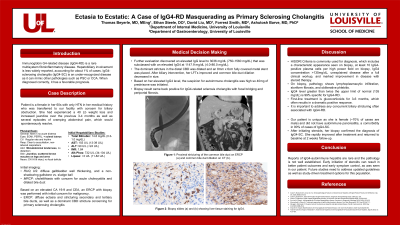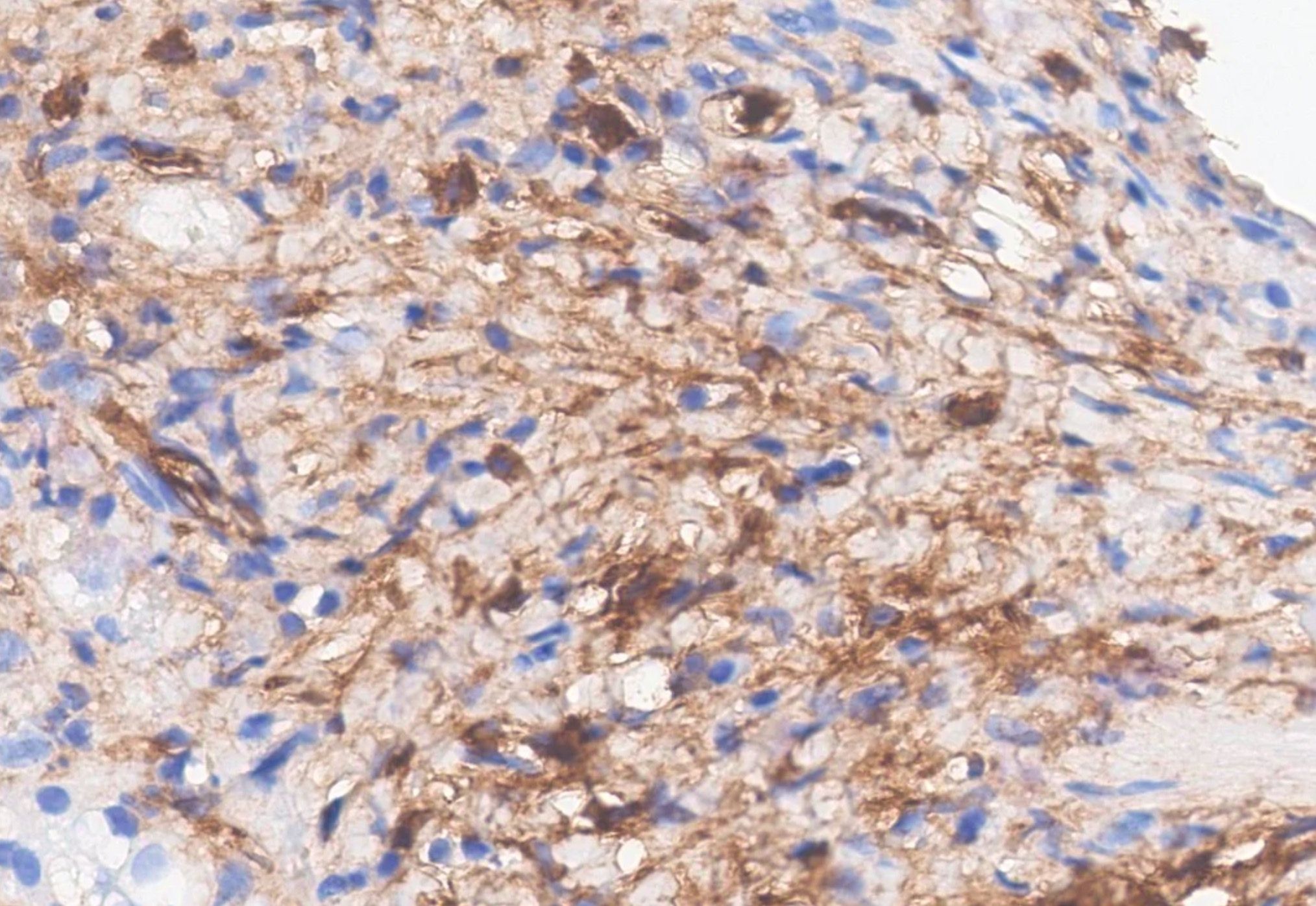Monday Poster Session
Category: Biliary/Pancreas
P1894 - Ectasia to Ecstatic: A Case of IgG4-RD Masquerading as Primary Sclerosing Cholangitis
Monday, October 28, 2024
10:30 AM - 4:00 PM ET
Location: Exhibit Hall E

Has Audio

Thomas Beyerle, MD, MEng
University of Louisville
Louisville, KY
Presenting Author(s)
Thomas Beyerle, MD, MEng1, David Liu, MD2, Forrest Smith, MD1, Ashutosh Barve, MD, PhD2
1University of Louisville, Louisville, KY; 2University of Louisville School of Medicine, Louisville, KY
Introduction: Immunoglobin G4-related disease (IgG4-RD) is a rare multisystem fibroinflammatory disease that can involve virtually any organ in the body. Hepatobiliary involvement is less widely reported, accounting for about 1% of cases. IgG4-sclerosing cholangitis is an under-recognized disease as it can mimic other pathologies such as primary sclerosing cholangitis (PSC) or cholangiocarcinoma (CCA) at the time of initial diagnosis. When diagnosed correctly and treated it has a favorable prognosis.
Case Description/Methods: Patient is a female in her 60s with only HTN in her medical history who was transferred to our facility for biliary obstruction and jaundice. She had also experienced a 40 Lb weight loss over previous 3-4 months. On admission, her total bilirubin was elevated to 14.8 mg/dL (0.3-1.0 mg/dL), INR 1.84, AST 155 U/L (13-39 U/L), ALT 90 U/L (< 24 U/L), Alk Phos 732 U/L (34-104 U/L), lipase < 3 U/L (11-82 U/L) and CEA was 603 ng/mL (0-2.5 ng/mL). She underwent ERCP was found to have a distal CBD stricture stented with 8mm x 6cm VIABIL stent. Occlusion cholangiogram demonstrated multiple areas of ectasia and stricturing of the intrahepatic bile ducts. Diagnosis of PSC was initially assumed, however IgG was elevated at 3036 mg/dL (750-1560 mg/dL), ANA/Hep panel were negative. IgG4 was elevated at 1147.9 mg/dL (4.0-86.0 mg/dL). Liver biopsy was obtained and stained strongly for IgG4. Steroids were initiated inpatient and when she returned to her 1 week follow up she marked improvement in her symptoms and total bilirubin was 4.9 with plans for a long taper and close follow up.
Discussion: A diagnosis for IgG4-RD is currently based on clinical and histopathological features and is a challenging diagnosis to obtain. Commonly HISTORt Criteria is used, which includes a characteristic appearance seen on biopsy, at least 10 IgG4-positive plasma cells per high power field on biopsy, increased IgG4 concentration >135mg/dL, unexplained disease after a full clinical workup, and marked improvement in disease with steroid therapy. On biopsy, pathology shows lymphoplasmatic infiltration, storiform fibrosis, and obliterative phlebitis. IgG4 level greater than twice the upper limit of normal (135 mg/dL) is 99% specific for IgG4-RD. Our patient is interesting as she is female (~70% of cases are male) and did not have autoimmune pancreatitis, a comorbidity in 90% of cases of IgG4-SC. Our case is still evolving as we follow her progress and seek to add to the literature of this very uncommon condition.

Disclosures:
Thomas Beyerle, MD, MEng1, David Liu, MD2, Forrest Smith, MD1, Ashutosh Barve, MD, PhD2. P1894 - Ectasia to Ecstatic: A Case of IgG4-RD Masquerading as Primary Sclerosing Cholangitis, ACG 2024 Annual Scientific Meeting Abstracts. Philadelphia, PA: American College of Gastroenterology.
1University of Louisville, Louisville, KY; 2University of Louisville School of Medicine, Louisville, KY
Introduction: Immunoglobin G4-related disease (IgG4-RD) is a rare multisystem fibroinflammatory disease that can involve virtually any organ in the body. Hepatobiliary involvement is less widely reported, accounting for about 1% of cases. IgG4-sclerosing cholangitis is an under-recognized disease as it can mimic other pathologies such as primary sclerosing cholangitis (PSC) or cholangiocarcinoma (CCA) at the time of initial diagnosis. When diagnosed correctly and treated it has a favorable prognosis.
Case Description/Methods: Patient is a female in her 60s with only HTN in her medical history who was transferred to our facility for biliary obstruction and jaundice. She had also experienced a 40 Lb weight loss over previous 3-4 months. On admission, her total bilirubin was elevated to 14.8 mg/dL (0.3-1.0 mg/dL), INR 1.84, AST 155 U/L (13-39 U/L), ALT 90 U/L (< 24 U/L), Alk Phos 732 U/L (34-104 U/L), lipase < 3 U/L (11-82 U/L) and CEA was 603 ng/mL (0-2.5 ng/mL). She underwent ERCP was found to have a distal CBD stricture stented with 8mm x 6cm VIABIL stent. Occlusion cholangiogram demonstrated multiple areas of ectasia and stricturing of the intrahepatic bile ducts. Diagnosis of PSC was initially assumed, however IgG was elevated at 3036 mg/dL (750-1560 mg/dL), ANA/Hep panel were negative. IgG4 was elevated at 1147.9 mg/dL (4.0-86.0 mg/dL). Liver biopsy was obtained and stained strongly for IgG4. Steroids were initiated inpatient and when she returned to her 1 week follow up she marked improvement in her symptoms and total bilirubin was 4.9 with plans for a long taper and close follow up.
Discussion: A diagnosis for IgG4-RD is currently based on clinical and histopathological features and is a challenging diagnosis to obtain. Commonly HISTORt Criteria is used, which includes a characteristic appearance seen on biopsy, at least 10 IgG4-positive plasma cells per high power field on biopsy, increased IgG4 concentration >135mg/dL, unexplained disease after a full clinical workup, and marked improvement in disease with steroid therapy. On biopsy, pathology shows lymphoplasmatic infiltration, storiform fibrosis, and obliterative phlebitis. IgG4 level greater than twice the upper limit of normal (135 mg/dL) is 99% specific for IgG4-RD. Our patient is interesting as she is female (~70% of cases are male) and did not have autoimmune pancreatitis, a comorbidity in 90% of cases of IgG4-SC. Our case is still evolving as we follow her progress and seek to add to the literature of this very uncommon condition.

Figure: Figure 1: Biopsy slide showing liver tissue staining for IgG4.
Disclosures:
Thomas Beyerle indicated no relevant financial relationships.
David Liu indicated no relevant financial relationships.
Forrest Smith indicated no relevant financial relationships.
Ashutosh Barve indicated no relevant financial relationships.
Thomas Beyerle, MD, MEng1, David Liu, MD2, Forrest Smith, MD1, Ashutosh Barve, MD, PhD2. P1894 - Ectasia to Ecstatic: A Case of IgG4-RD Masquerading as Primary Sclerosing Cholangitis, ACG 2024 Annual Scientific Meeting Abstracts. Philadelphia, PA: American College of Gastroenterology.
